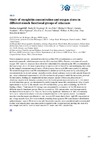Identificador persistente para citar o vincular este elemento:
https://accedacris.ulpgc.es/jspui/handle/10553/71335
| Título: | Study of myoglobin concentration and oxygen stores in different muscle functional groups of cetaceans | Autores/as: | Arregui Gil, Marina Singleton, Emily M. Pabst, Ann Moore, Michael J. Fernández Rodríguez, Antonio Jesús Niemeyer, Misty Sierra Pulpillo, Eva María Fahlman, Andreas McLellan, William A. Bernaldo de Quirós Miranda, Yara |
Clasificación UNESCO: | 310907 Patología 3109 Ciencias veterinarias |
Fecha de publicación: | 2016 | Resumen: | Marine mammals possess increased muscle myoglobin (Mb) concentration as compared to terrestrial mammals, which increases aerobic dive duration (ADL). Previous estimates of muscle oxygen (O2) stores in cetaceans have often been determined by measuring the Mb concentration in the longissimus dorsi, the muscle powering the upstroke of the dorsal fin, and multiplying that value by the animal’s locomotor muscle mass, which assumes that muscle Mb concentration is uniform. We tested the hypothesis that Mb concentration is similar across body muscles by calculating Mb concentration in six muscle groups (mastohumeralis, dorsal scalenus, sternohyoid, epaxial, hypaxial and rectus abdominis) representative of different functional groups (caudal fin movement, pectoral fin movement, feeding and respiration) in four cetacean species (Phocoena phocoena n=1; Delphinus delphis n=4; Stenella coeruleoalba n=4; Globicephala macrorhynchus n=1). O2 stored in each functional group was determined by multiplying the mean Mb concentration value of each representative muscle by the muscle mass of that functional group, and considering the Mb-O2 binding affinity. Total muscle O2 storage was determined by summation of the O2 stores in the different muscle functional groups. Results showed that Mb concentration was heterogeneously distributed between and within muscles. Statistically significant differences in Mb concentration were found between locomotor and non-locomotor muscles of the species studied. Locomotor muscles were the major contributors to total muscles O2 stores due to both, high Mb concentration and a large muscle mass. Previous methods assuming homogeneous Mb concentration distribution underestimated muscle O2 stores when only locomotor muscles were considered and overestimated it when total muscle mass was considered compared to the present method, proving the need of a new simple method for more accurate muscle O2 stores and ADL calculations. | URI: | https://accedacris.ulpgc.es/handle/10553/71335 | Fuente: | 30th Annual Conference of the European Cetacean Society. Madeira, Portugal, 14-16 March 2016 / Luís Freitas; Cláudia Ribeiro (ed.), p. 257 |
| Colección: | Actas de congresos |
Visitas
148
actualizado el 31-may-2025
Descargas
46
actualizado el 31-may-2025
Google ScholarTM
Verifica
Comparte
Exporta metadatos
Los elementos en ULPGC accedaCRIS están protegidos por derechos de autor con todos los derechos reservados, a menos que se indique lo contrario.
